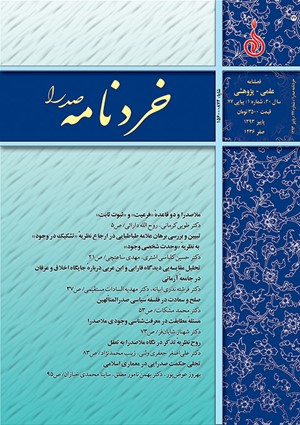تجلي حكمت صدرايي در معماري اسلامي
محورهای موضوعی : ملاصدراپژوهی و اندیشۀ حکمت متعالیهبهروز عوضپور 1 , بهمن نامور مطلق 2 , ساينا محمدي خبازان 3
1 - دانشگاه هنرهاي اسلامي تبريز
2 - دانشگاه شهيد بهشتي
3 - دانشگاه تهران
کلید واژه: ملاصدرا هنر اسلامي خيال كنش هنري معماري ,
چکیده مقاله :
با توجه به اين نكته كه تفكرات حكمي فلسفي ملاصدرا در آثار هنري زمان وي و بطور خاص معماري آن دوره تجسم يافته است، بنظر ميرسد براي فهم درست و بهتر هنر و معماري آن دوران و رابطه» آن با نظريات فلسفي ـ عرفاني ملاصدرا، لازم است آراء و ديدگاههاي وي در اينباره را بدقت مورد بحث و بررسي قرار دهيم. ازآنجاكه مفهوم خيال در تعريف هنر اسلامي از منظر ملاصدرا و ديگر حكما و عرفاي اسلامي نقش اساسي را ايفا ميكند، در اين نوشتار نخست به آن بخش از فلسفة ملاصدرا ميپردازيم كه به شرح و بيان مفهوم خيال ميپردازد، سپس نقش و بتبع آن جايگاه خيال در كنش هنري به مفهوم عام آن را معين كرده و روند فعليت اين كنش را در معماري، بويژه معماري دوران صفوي بررسي ميكنيم. محوريت خيال در اين مبحث تا بدانجاست كه ميتوان هنر اسلامي را در كليت آن به تجلي امر معقول در امر محسوس از طريق تخيل فعال تعريف كرد.
Mulla Sadra’s philosophical thoughts profoundly influenced the development of art, in general, and the architecture of his time, in particular. Therefore, it seems necessary to carefully examine and discuss his ideas and theories in this regard in order to have a better and more accurate understanding of the art and architecture of that period. Since the concept of imagination plays a basic role in the definition of Islamic art from the point of view of Mulla Sadra and other Islamic philosophers and gnostics, in this paper the writers firstly deal with a part of his philosophy that explains this concept. Following this, they will refer to the role and place of imagination in art works in their general sense and explore the actualization of such works in the field of architecture, particularly, those of the Safavid era. Imagination plays such a central role in this discussion that one can define Islamic art in its general sense as the manifestation of an intelligible matter in a sensible one through active imagination.
قرآن كريم.#
ابراهيمي ديناني، غلامحسين، شعاع شهود و انديشه در فلسفة سهروردي، تهران، حكمت، 1390.#
ابنسينا، الاشارات و التنبيهات، بهمراه شرح خواجه نصيرالدين طوسي و شرح الشرح قطب الدين رازي، قم، نشر البلاغه، 1375.#
ابنسينا، الشفاء، الطبيعيات، تصحيح و مقدمة ابراهيم مدكور، قم، كتابخانة آيتالله مرعشي، 1404ق.#
ابنسينا، طبيعيات دانشنامة علايي، تصحيح محمد معين و سيدمحمد مشكوة، تهران، دهخدا، 1353.#
ابن عربي، محي الدين، فصوص الحكم، تصحيح ابوالعلا عفيفي، نينوي، مكتبه دارالثقافه، 1946م.#
استيرلن، هانري، اصفهان تصوير بهشت، ترجمة جمشيد ارجمند، تهران، نشر فرزان، 1377.#
امامي جمعه، سيدمهدي، فلسفة هنر در عشق شناسي ملاصدرا، تهران، فرهنگستان هنر، 1388.#
بوركهارت، تيتوس، مباني هنر اسلامي، ترجمة امير نصيري، تهران، حقيقت، 1386.#
سهروردي (شيخ اشراق)، شهاب الدين يحيي، مجموعه مصنفات شيخ اشراق، تصحيح هانري كربن و سيدحسين نصر، تهران، پژوهشگاه علوم انساني و مطالعات فرهنگي، 1380.#
عطار، فريدالدين، مصيبتنامه، تهران، زوار، 1338.#
عوضپور، بهروز، درآمدي بر نظريههاي هنر، تبريز، موغام، 1392.#
كربن، هانري، ابن سينا و تمثيل عرفاني، ترجمة انشاءالله رحمتي، تهران، نشر جامي، 1387.#
كربن، هانري، مباني هنر معنوي، ترجمة سيد حسين نصر و ديگران، تهران، دفتر مطالعات ديني هنر، 1376.#
مددپور، محمد، حكمت معنوي و ساحت هنر، تهران، سورة مهر، 1371.#
ملاصدرا، تفسير القرآن الكريم، ج1، با مقدمة سيدمحمد خامنهاي، تهران، بنياد حكمت اسلامي صدرا، 1389.#
ملاصدرا، الحكمة المتعاليه في الاسفار العقلية الاربعه، ج7: تصحيح، تحقيق و مقدمة مقصود محمدي، تهران، بنياد حكمت اسلامي صدرا، 1380.#
ملاصدرا، الحكمة المتعاليه في الاسفار العقلية الاربعه، ج8: تصحيح، تحقيق و مقدمة علي اكبر رشاد، تهران، بنياد حكمت اسلامي صدرا، 1383.#
ملاصدرا، الشواهد الربوبيه في المناهج السلوكيه، تصحيح، تحقيق و مقدمة سيدمصطفي محقق داماد، تهران، بنياد حكمت اسلامي صدرا، 1382.#
ملاصدرا، رسالة سه اصل، تصحيح، تحقيق و مقدمه، سيد حسين نصر، تهران، بنياد حكمت اسلامي صدرا، 1390.#
ملاصدرا، مفاتيح الغيب، تصحيح، تحقيق و مقدمة نجفقلي حبيبي، تهران، بنياد حكمت اسلامي صدرا، 1386.#
مولوي، جلالالدين محمد، مثنوي معنوي، تهران، اميركبير، 1373.#
نصر، سيدحسين، «عالم خيال و مفهوم فضا در مينياتور ايراني» مجله فرهنگ و هنر، شماره26.#
نصر، سيدحسين، هنر و معنويت اسلامي، ترجمة رحيم قاسميان، تهران، دفتر مطالعات ديني هنر، 1375.#


